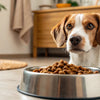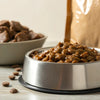Is Wet Food Good for Dogs Every Day? A Comprehensive Guide for Pet Owners
- Houndsy
Table of Contents
- Introduction
- Understanding Wet Dog Food
- How Often Should Dogs Have Wet Food?
- Tips for Transitioning to Wet Food
- Creating a Balanced Diet
- The Role of Houndsy in Elevating Pet Care
- Conclusion
Introduction
Did you know that approximately 60% of pet owners find themselves confused about the best feeding practices for their dogs? As loving pet parents, we want to ensure that our furry friends receive the proper nutrition to thrive, yet the vast array of options and the conflicting opinions can often be overwhelming. One question that frequently arises in our shared community is: Is wet food good for dogs every day? This inquiry is not merely about the frequency of feeding; it encompasses a broader understanding of the nutritional benefits of wet food, its role in a balanced diet, and how it fits into our dogs' daily feeding routines.
In this blog post, we will dive into everything you need to know about incorporating wet food into your dog's diet. We will explore the benefits of wet food, the recommended feeding frequency based on various factors such as age and size, and practical tips for transitioning to wet food if you haven't yet. By the end of this article, you will possess a comprehensive understanding of how to effectively use wet food in your dog's diet, ensuring they maintain a healthy and balanced lifestyle.
Let’s embark on this exploration together as we uncover the many aspects of wet dog food and its benefits for our beloved pets.
Understanding Wet Dog Food
What is Wet Dog Food?
Wet dog food, often sold in cans or pouches, contains higher moisture content compared to dry kibble, generally ranging from 70% to 80%. This moisture-rich formulation can be particularly beneficial for dogs that may struggle to drink sufficient water or those having specific health conditions. The primary ingredients in wet food generally include:
- Meat: A primary source of protein that dogs crave, often including chicken, beef, lamb, or fish.
- Grains and Vegetables: These add nutritional value and fiber, promoting healthy digestion.
Overall, wet dog food presents a well-rounded nutritional profile that many pet owners find appealing.
Benefits of Wet Dog Food
The advantages of wet food can significantly enhance your dog's overall health. Here are a few reasons to consider including wet food in your dog's diet:
1. Hydration
Because of its high moisture content, wet food can help keep your dog hydrated, which is especially important for those who may not drink enough water throughout the day. This can be crucial for dogs with urinary tract issues or kidney problems.
2. Palatability
Wet food tends to be more aromatic and flavorful than dry kibble, making it an enticing option for picky eaters or older dogs whose appetites may have diminished. The appealing texture and flavors can motivate them to consume more food.
3. Digestibility
The softer consistency of wet food can be easier on dogs with dental issues or those recovering from surgery. This can aid in ensuring they receive sufficient nutrition even during recovery periods.
4. Nutritional Variety
Wet food often comes in various flavors and formulations, allowing pet owners to provide a diverse diet that caters to their dog's specific health requirements. Variety can reduce mealtime boredom and contribute to a healthier overall diet.
Nutritional Considerations
While wet food offers numerous benefits, it is essential to ensure that it meets your dog's nutritional needs. Always look for products labeled as "complete and balanced," and check for the Association of American Feed Control Officials (AAFCO) statement on the packaging. This ensures that the food adheres to regulations regarding nutritional adequacy for your dog's life stage.
How Often Should Dogs Have Wet Food?
Age and Size Considerations
Feeding frequency can vary based on several factors, including your dog's age, size, and overall health. Here’s a breakdown of how often to feed wet food based on these key factors:
Puppies
Young dogs require more frequent feedings due to their rapid metabolism and growth. Puppies under six months old may need to eat three to four times a day. If you introduce wet food into their diet, it's vital to monitor their overall caloric intake to ensure they receive the necessary nutrition without overfeeding.
Adult Dogs
Most adult dogs generally thrive on one or two meals per day. When including wet food, some pet owners opt to serve it at one meal and dry kibble at another, creating a balanced diet while still allowing for the benefits that wet food offers.
Senior Dogs
Senior dogs may experience changes in appetite and health conditions that necessitate tailored feeding. Many owners find it beneficial to include wet food more frequently (up to twice a day) to encourage older dogs to eat, particularly if they have dental concerns or a decreased appetite.
Feeding Strategies
When determining how often to incorporate wet food into your dog's diet, consider these strategies:
- Scheduled Feeding: Setting specific meal times helps regulate your dog’s eating habits and prevents overeating.
- Free-Choice Feeding: While some pet owners leave food out for their dogs throughout the day, this method is generally discouraged for wet food due to its shorter spoilage timeframe.
Mixing Wet and Dry Food
Many pet owners achieve great results by mixing wet and dry food. This combination not only provides the palatability benefits of wet food but also maintains the convenience of dry kibble. If you choose to mix, adjust the portion sizes accordingly; for instance, if your dog typically eats one cup of dry kibble, reduce that amount and include a half can of wet food instead.
Tips for Transitioning to Wet Food
If you’re considering adding wet food to your dog's diet, transitioning need not be daunting. Here are some practical tips to ensure a smooth introduction:
1. Gradual Introduction
Start by mixing a small amount of wet food into your dog’s regular dry food. Gradually increase the wet proportion over several days or weeks to avoid digestive upset.
2. Monitor Reactions
Observe your dog’s reaction during the transition. If there are any signs of discomfort or allergies, reach out to your veterinarian.
3. Watch Portion Sizes
Ensure you adjust the total daily intake of food to account for the calories in wet food. This adjustment is vital to maintaining a healthy weight for your dog.
4. Storage and Freshness
Always store opened cans or pouches in the refrigerator, using them within a few days for optimal freshness. Serving the food at room temperature can enhance its aroma and flavor, making it more appealing to your dog.
Creating a Balanced Diet
Portion Control
Understanding appropriate portion sizes is crucial when introducing wet food to your dog's routine. Most pet food brands offer feeding guidelines based on your dog's weight. For instance, a 30-pound dog may require approximately 2 to 3 cans of wet food daily, though this can vary based on the food’s caloric density. Always check the packaging for specific recommendations.
Consultation with a Veterinarian
If you are uncertain about the specific amount of wet food or how often to incorporate it into your dog’s diet, consulting your veterinarian can provide personalized insights. They can offer tailored advice based on your dog’s health needs, age, activity level, and lifestyle.
The Role of Houndsy in Elevating Pet Care
At Houndsy, we understand that the act of feeding our pets should be a joyful and rewarding experience for both dogs and their owners. Our mission is to simplify and elevate the daily feeding process by addressing common challenges that pet owners face.
Our flagship product, the Houndsy Kibble Dispenser, exemplifies our commitment to innovative design. Combining mid-century modern aesthetics with ergonomic functionality, it allows for perfect portion control at standing height—eliminating the need for bending down while providing a beautiful addition to your home decor.
The large storage capacity of our dispenser (25-30 lbs) ensures you have enough food on hand, while the BPA-free liner maintains freshness and prevents spoilage. Plus, the auto-locking mechanism protects against accidental dispensing by curious pets or toddlers. By using the Houndsy Kibble Dispenser, you can ensure that your dog receives the right amount of food every time—making mealtime a delight rather than a chore.
Conclusion
Incorporating wet food into your dog’s diet can provide hydration, improve palatability, enhance digestibility, and bring variety to their meals. Understanding how often to feed wet food based on your dog’s age, size, and health needs is essential for maintaining their well-being. As we nurture our dogs with the right meals, we also have the opportunity to elevate their feeding experience.
Utilizing innovative products like the Houndsy Kibble Dispenser allows us to streamline the feeding process and create a harmonious environment for both pets and pet owners. Are you ready to enhance your dog's feeding experience? Explore our Kibble Dispenser today!
FAQ
-
Can I mix wet and dry dog food? Yes, combining wet and dry food can provide a balanced diet and enhance the palatability of meals. Just ensure you adjust the portion sizes accordingly to prevent overfeeding.
-
How often should I feed my puppy wet food? Puppies generally require more frequent meals, typically three to four times a day. Monitor their growth and adjust portions as needed.
-
Is wet food better for older dogs? Wet food can be beneficial for older dogs due to its softer texture and higher moisture content, which can encourage them to eat, especially with dental issues.
-
How do I store opened wet dog food? Once opened, wet dog food should be stored in the refrigerator and used within a few days to maintain freshness.
-
What should I do if my dog refuses to eat wet food? If your dog is hesitant to eat wet food, try mixing it with their regular dry food or warming it slightly to enhance the aroma. If they continue to refuse, consult your veterinarian for advice.












